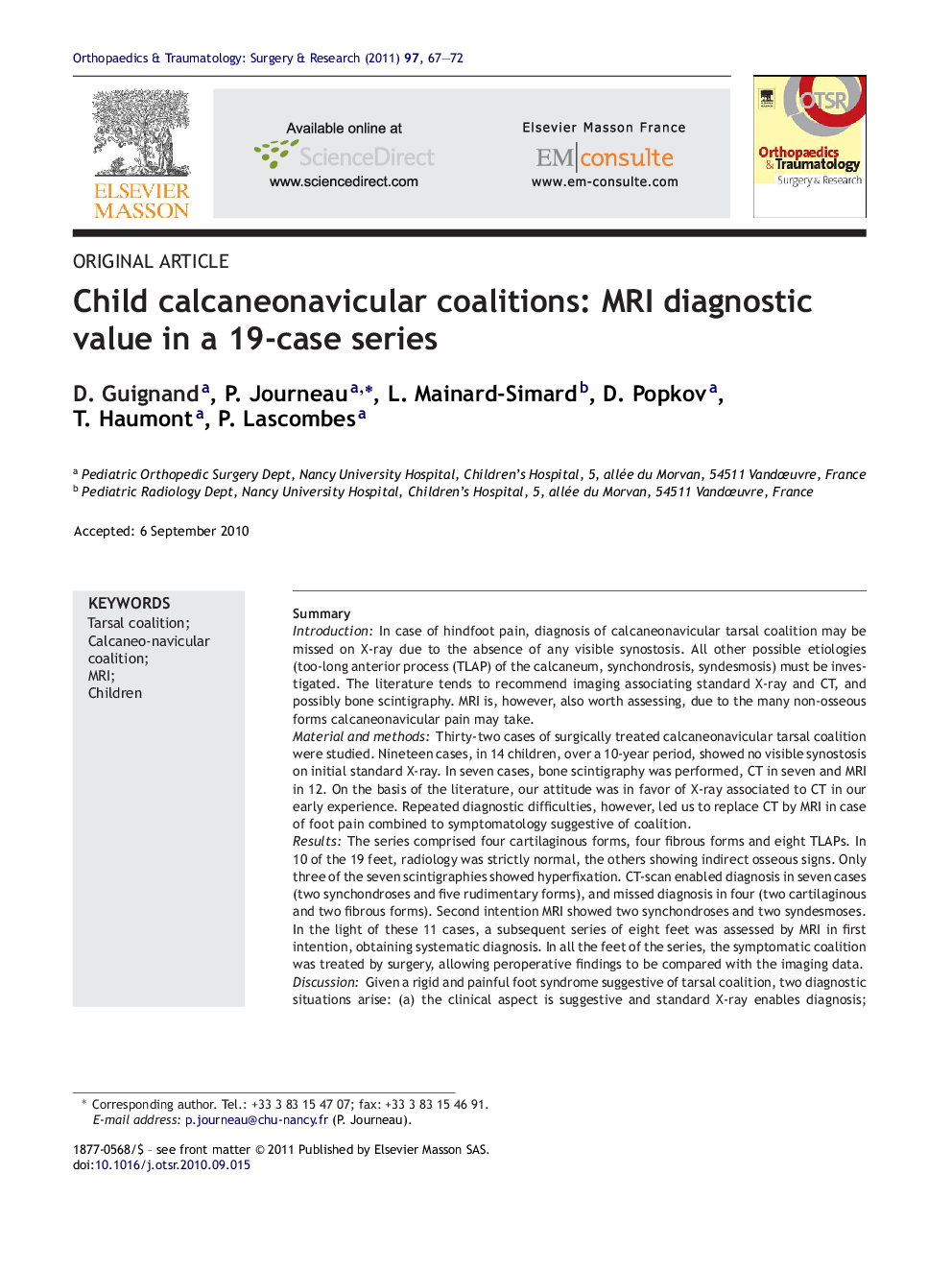| کد مقاله | کد نشریه | سال انتشار | مقاله انگلیسی | نسخه تمام متن |
|---|---|---|---|---|
| 4082131 | 1267624 | 2011 | 6 صفحه PDF | دانلود رایگان |

SummaryIntroductionIn case of hindfoot pain, diagnosis of calcaneonavicular tarsal coalition may be missed on X-ray due to the absence of any visible synostosis. All other possible etiologies (too-long anterior process (TLAP) of the calcaneum, synchondrosis, syndesmosis) must be investigated. The literature tends to recommend imaging associating standard X-ray and CT, and possibly bone scintigraphy. MRI is, however, also worth assessing, due to the many non-osseous forms calcaneonavicular pain may take.Material and methodsThirty-two cases of surgically treated calcaneonavicular tarsal coalition were studied. Nineteen cases, in 14 children, over a 10-year period, showed no visible synostosis on initial standard X-ray. In seven cases, bone scintigraphy was performed, CT in seven and MRI in 12. On the basis of the literature, our attitude was in favor of X-ray associated to CT in our early experience. Repeated diagnostic difficulties, however, led us to replace CT by MRI in case of foot pain combined to symptomatology suggestive of coalition.ResultsThe series comprised four cartilaginous forms, four fibrous forms and eight TLAPs. In 10 of the 19 feet, radiology was strictly normal, the others showing indirect osseous signs. Only three of the seven scintigraphies showed hyperfixation. CT-scan enabled diagnosis in seven cases (two synchondroses and five rudimentary forms), and missed diagnosis in four (two cartilaginous and two fibrous forms). Second intention MRI showed two synchondroses and two syndesmoses. In the light of these 11 cases, a subsequent series of eight feet was assessed by MRI in first intention, obtaining systematic diagnosis. In all the feet of the series, the symptomatic coalition was treated by surgery, allowing peroperative findings to be compared with the imaging data.DiscussionGiven a rigid and painful foot syndrome suggestive of tarsal coalition, two diagnostic situations arise: (a) the clinical aspect is suggestive and standard X-ray enables diagnosis; (b) the clinical aspect is suggestive, but radiography proves non-contributive, in which case we recommend MRI with sagittal, frontal and axial slices in gadolinium-enhanced T1-weighted and fat-sat T2-weighted sequences, revealing direct (cartilaginous or fibrous coalition) or indirect signs (peripheral inflammation, osteomedullary edema, chondral lesion) unobtainable on CT scans. MRI is particularly effective in as much as most of the children concerned will not have reached bone maturity.ConclusionWe consider MRI to be the most effective means of precise diagnosis (causes and consequences) of tarsal coalition, especially for calcaneonavicular locations. It entails minimal invasion and irradiation, at a lower cost than CT associated to scintigraphy.Level of evidenceIV. Diagnostic study.
Journal: Orthopaedics & Traumatology: Surgery & Research - Volume 97, Issue 1, February 2011, Pages 67–72